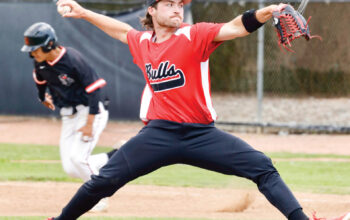Brian Schwartz special to the Roundup
As the hot sun shines down, a loud whistle blows. Grumbles fill the background as their feet move rapidly in and around the gates. Grass is kicked up, and off they go. Sprinting 20 yards ahead, trying to make it to the line first.
Exhausted breathing.
Sweaty bodies.
This is football practice in the heat.
Since 1995, 38 players have died from heat stroke at the high school, college, and professional levels, according to the Annual Survey of Football Injury Research by Frederick O. Mueller. While great research has been done to find out how WBGT can affect humans, there are still cases of obvious neglect of extreme temperatures that can be rather dangerous for atheletes at any level.
In order to prevent any heat-related illnesses and deaths, coaches at the college level have had to alter their practice routines due to the heat and also be careful of heat warnings and safety.
“We keep practice less than 45 minutes due to the heat,” said Pierce College Strength and Conditioning Coach Matt Hank.
However, other coaches feel that the heat doesn’t require a change in practice routine.
Pierce Head Coach Efrain Martinez said the only thing that his players have had to do differently is drink more water.
“There has only been two hot days, but it has cooled off quickly,” said Martinez. “We just need to have more ice and cooler water.”
Practicing under the hot sun has taken its toll on the players.
“[The sun] drains your body a little bit,” said Pierce Wide Receiver Damon Julian. “The more hydrated you are, the easier it is,” said Julian.
The heat has even made some players not want to attend practice.
“It dampens my spirit,” said Pierce Offensive Left Guard Brandon Hammond.
Pierce Quarterback Clinton Granger had the same thoughts about not wanting to attend practice.
“Sometimes I don’t want to go,” said Granger. “But we have no choice.”
Although many players are discouraged about practicing in the heat, some players feel that the heat is good for their bodies.
Pierce Running Back Josh Johnson said that practicing in the heat is great.
“It makes you better,” said Johnson. “It gives you the great conditioning that you need.”
Pierce Center Andrew Duenes thinks that the heat makes the players better.
“I want to come [to practice] more because I know that I’ll get a better workout,” said Duenes. “Once I get used to [the heat] I’ll be good.”
Whether the players choose to attend practice or not, they still need to prepare their bodies for the heat. Many players drink water before practice so that they don’t get dehydrated.
Pierce Defensive Tackle Lucas Melo said that he drinks a lot of water before hitting the field.
“I try to get a gallon before practice,” said Melo.
“I drink water all throughout the day to stay hydrated,” said Johnson.
Pierce Wide Receiver Davonte Sykes said that he drinks water 10 times per day, which is at least a gallon.
When practicing in the heat, there are many situations that coaches have to take into consideration. Players are susceptible to different heat-related illnesses, and the coaches have to make sure that their players stay healthy.
Dr. Roger On, a cardiologist, said that the most common illness that players are susceptible to is cramping.
“If you are in too high heat and you get dehydrated, you lose electrolytes, which are needed for your muscles to contract,” said On.
Pierce Assistant Coach Jim Thornton said that the players need to drink a lot of water in order to prevent muscle cramps.
“Gotta make sure they stay hydrated all throughout the day,” said Thornton.
Beth Benne director of the health center said that the key to preventing heat-related illnesses is to “hydrate, hydrate, hydrate.”
In order to treat these illnesses, the coaches have to take their players out of the sun and into the shade.
“You cool them down,” said Benne. “Use cool cloths on their forehead.”
The most serious heat-related illnesses that players are susceptible to are heat exhaustion and heat stroke.
Benne said that these conditions are so serious that players can die from them.
Korey Stringer of the Minnesota Vikings died in 2001 due to heatstroke. Stringer was practicing when it was 91-degrees outside, and he collapsed in front of a Vikings trainer.
Stringer was the first National Football League player to die from heatstroke since the formation of the league over 90 years ago, according to wsws.org.
Football is a tough sport, and the heat is just one component of it.
“[The heat] is just part of football,” said Pierce Defensive Tackle Julian Fields. “It’s your choice to play this sport, so you can’t complain.”

The Pierce College football team conditioning in the summer heat on July 20. (Brian Schwartz special to the Roundup)


